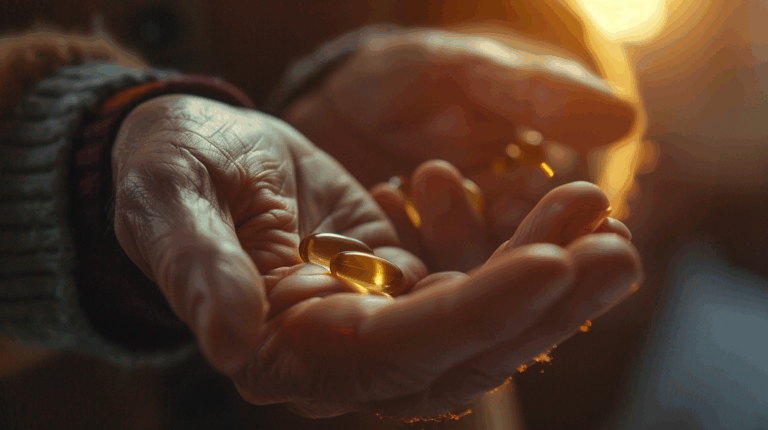By Mike, The SugarFreeMan
Founder of SugarDetox.com and the 30-Day Sugar Freedom Challenge
In a lot of ways, they are.
And in your heart. And in your emotions.
That’s not the answer most people want to hear. They want me to say it’s all physical – just detox for a few days and you’re free. Or they want me to say it’s all mental – just use willpower and positive thinking.
But after 35 years sugar-free and helping tens of thousands of people through this process, I’ve learned something that changes everything:
Once we get through the physical detox of sugar – that’s when the real work starts.
The physical cravings? Those are intense, but they’re predictable. They pass. The emotional and mental cravings that come after? Those are the ones that blindside people. Those are the ones that send people back to sugar after 30, 60, or even 90 days clean.

Understanding the difference between physical cravings and emotional cravings – and knowing how to handle both – is the key to long-term sugar freedom instead of another temporary diet.
This article was review by Dr. Camela McGrath, MD, FACOG. Find more about her here
First, Let’s Get Real About the Physical Part
I need to state this clearly because people get confused:
Without 100% physical abstinence from sugar for the first 14 to 30 days, you will have VERY strong physical cravings. Period. End of discussion.
Having sugar (and flour) in your system causes powerful physical cravings – for some people more than others, but for true sugar addicts, it’s undeniable.
This isn’t about willpower or being weak. Research from the National Institutes of Health shows that sugar activates the same reward pathways in the brain as cocaine and other addictive drugs. Your body becomes physiologically dependent.
During those first weeks, your body is:
- Withdrawing from a substance it’s adapted to having regularly
- Rebalancing blood sugar levels that have been on a roller coaster
- Adjusting insulin response that’s been overstimulated for years
- Recalibrating neurotransmitter production (especially dopamine and serotonin)
- Healing inflammation throughout the body
These are physical processes. They create physical cravings. They’re real, they’re intense, and they require complete abstinence to resolve.
You cannot half-quit sugar during this phase. You cannot “just a little bit” your way through physical detox. It’s like being “just a little bit pregnant” – it doesn’t work that way.
The Diet Industry Doesn’t Want You to Know This
We’ve all been on a diet where we cut back on sugar and carbs or even quit completely. How long it lasts depends on each individual and a whole host of variables.
But here’s a sobering fact: less than 2% of all people who attempt a diet or weight loss program ever succeed and maintain consistent weight loss for more than just a few months.
This fact is well proven by thousands of university studies. The diet industry makes billions because people keep failing and trying again. They blame you for lacking willpower when the real problem is that temporary restriction doesn’t address the underlying addiction.
With all that out of the way, we’re free to answer the real question.
So Could Sugar Cravings Be All In Your Head?
Now I didn’t have room in the headline to say: “Could sugar cravings be all in your head, your heart, and your emotions?” But that’s the real question:
Are sugar cravings less physical and more in the realm of mental or emotional issues than a straight physical sensation?
After the initial detox phase, absolutely yes.
But here’s where it gets complicated – and where most people get tripped up.

The Question I’ve Heard Thousands of Times
People always ask WHY?
I mean thousands of times over the years. Thousands.
They ask:
“Why can’t I just put this stuff down? I don’t even like it anymore.”
That’s the key phrase right there: “I don’t even like it anymore.”
They’re past the physical addiction. The sugar doesn’t even taste that good to them anymore. They know how terrible it makes them feel. They see the weight gain, the brain fog, the energy crashes.
So why do they keep going back?
The answer just makes people mad at first. I don’t know any other way to say it. That’s what happens. They say it can’t be so. It can’t be possible.
But here’s the thing:
90+% of those folks have never been exposed to a person who has had success putting sugar down for any extended time period.
As you might imagine, those folks are still in that less than 2% minority – so they’re still rare. Most people have never actually talked to someone who’s been sugar-free for years and can explain what the journey really looks like.
What Successful People Would Tell You (If You Could Sit Down With Them)
If you were exposed to people who’ve maintained long-term sugar freedom, and you could sit down and talk with them for an hour or so, here’s what those successful folks – sitting there in their right-sized bodies – would tell you:
“The first year was kinda rocky.”
“I felt better physically right away. I lost weight every single week. I was looking awesome! My brain fog cleared, my skin cleared up, and I flat out got skinny for the first time in my life!”
Sounds amazing, right? And it is. But there’s a BUT.
And as you can see, it’s a BIG but.
The Part Nobody Warns You About
They’d also tell you:
“I also had to go through some emotional changes. I cried for no reason and at all the wrong times. I got angry at inappropriate times. I kept remembering old hurts, emotional turmoil, and weird memories that I had totally forgotten about.”
In short, it seemed like my nervous system was being rebuilt – rewired. Like I had to relearn how to deal with stuff – my kids, my spouse, my friends, and my workmates.
Without the help of a bunch of folks who had navigated that ‘weirdness’ before me, I would have definitely returned to sugar.
Sugar had served me since I was little, and this new world of intense feelings was not one I was ready to deal with alone.
Ready to take back control and feel supported every step of the way? Join the 30-Day Sugar Detox Challenge today!
The kindness that these strangers bestowed on me I’ll never be able to repay. They comforted me when I was just beside myself and ready for an ice cream sundae.
You’re not just quitting a food. You’re removing your primary coping mechanism for dealing with emotions.
Why Sugar Becomes Your Emotional Manager
For most people with sugar addiction, sugar hasn’t just been a food. It’s been:
- Your stress manager – Had a hard day? Sugar made it better
- Your reward system – Accomplished something? Celebrate with sugar
- Your comfort in sadness – Feeling down? Sugar lifted your mood
- Your social lubricant – Awkward situation? Eating gave you something to do
- Your boredom solution – Nothing to do? Sugar created interest
- Your anger suppressant – Feeling rage? Sugar calmed you down
- Your anxiety reducer – Feeling worried? Sugar soothed your nerves
- Your loneliness companion – Feeling alone? Sugar was always there

Sugar has been serving you emotionally since you were little.
Maybe since childhood when you got a cookie after a hard day at school. Or ice cream when you were sad. Or cake at every celebration.
You learned – probably before you could even articulate it – that sugar makes hard feelings go away. At least temporarily.
Research from Harvard Medical School explains that sugar rapidly increases serotonin levels in the brain, creating a temporary mood boost. When you’re stressed, anxious, or sad, your brain remembers: “Sugar makes this feeling go away.”
So when you quit sugar, you’re not just dealing with physical withdrawal. You’re facing every emotion you’ve been numbing with sugar for years – maybe decades.
And you have no idea how to deal with them without sugar.
The Emotional Rewiring That Has to Happen
Here’s what happens after you get through the physical detox:
Week 3–4: The “I Feel Amazing” Phase
You’re past the worst of the physical symptoms. You’ve lost some weight. Your energy is stabilizing. You’re thinking: “I’ve got this!”
This is where most diet programs end. They assume you’re done.
But you’re not done. You’re just beginning.
Week 5–8: The Emotions Start Surfacing
Suddenly you’re crying during commercials. Or snapping at your spouse over nothing.
This isn’t you being crazy. This is your nervous system recalibrating.
Month 3–6: The Deep Healing
Old memories surface. Things you haven’t thought about in years suddenly feel raw.
It’s like your system is clearing out decades of unfelt feelings.
Month 6–12: Learning to Live Differently
You’re relearning how to live without sugar as your emotional manager.
You’re discovering how to:
- Sit with uncomfortable feelings
- Celebrate without sugar
- Handle stress in healthier ways
- Be present with your emotions
- Connect authentically with others
This is the real work of recovery.
The Truth About Mental and Emotional Cravings
So to answer the original question:
Yes, after the physical detox, sugar cravings are largely in your head, your heart, and your emotions.
But that doesn’t make them less real.
In fact, they’re often more powerful.
Physical cravings are short-lived, come in waves, and decrease within a few weeks.
Emotional cravings are tied to situations, memories, and feelings – and can last months or even years.
What Actually Works for Emotional Cravings
1. Identify the Real Need
Ask: “What am I really craving?”
Comfort? Reward? Stress relief? Connection?
Meet that need in a healthier way.
2. Learn to Sit With Discomfort
You have to learn that uncomfortable emotions won’t destroy you.
They come, they go, and they heal you when you feel them.
3. Build New Neural Pathways
Your brain’s old pattern: Stress → Sugar → Relief
Your new one: Stress → Healthy Coping → Real Relief
4. Get Support From People Who Understand
You can’t rewire your emotional system alone.
You need people who say:
- “Yes, this is normal.”
- “Yes, it passes.”
- “Yes, you can get through this.”
Why Most Programs Fail You at This Stage
Most programs focus on food and skip emotions.
The physical detox is the easy part. The emotional rewiring is where most people fail.
They give you a meal plan, wish you luck, and call it success.
But when emotions hit in month two or three, you’re left unprepared.
The truth?
You didn’t fail. The program failed you.
Until then, we’ll be holding down the fort here with a group of amazing people who know that sugar freedom requires more than a diet—it requires emotional healing, community, and connection.
Are You Ready for the Real Journey?
Sugar cravings after detox are mostly emotional-and that makes them harder, not easier.
You can’t think your way out of emotional healing.
You can only feel your way through it-with support.
Choose connection over willpower.
Choose healing over temporary control.
Choose freedom over comfort.
That’s what real freedom looks like. Not just being physically free from sugar, but emotionally free from needing it.
The Choice in Front of You
You have a choice:
- Another diet that ignores emotions
- Or a real path that heals both body and heart
If you’re ready to do the real work, to connect with others who’ve done it before you, join the 30-Day Sugar Detox Challenge.
They’re waiting to help you through both the physical and emotional rewiring that comes after.
See you on the inside.
About the Author
Mike Collins, known as “The SugarFreeMan,” has been sugar-free for over 35 years and is the founder of SugarDetox.com. He has helped tens of thousands of people break free from sugar addiction through his evidence-based approach combining nutritional science with practical behavior change strategies.
Medical Disclaimer
This article is for educational purposes only and is not intended to replace professional medical advice. Always consult with a healthcare provider before making significant dietary changes, especially if you have underlying health conditions.
FAQ
Q: Are sugar cravings physical or mental after you’ve been off sugar for a while? A: After completing 14-30 days of complete sugar abstinence, physical cravings largely resolve and most cravings become mental and emotional. These emotional cravings occur because sugar has served as your emotional manager since childhood – handling stress, sadness, boredom, and discomfort. When you quit sugar, you’re removing your primary coping mechanism and must relearn how to handle emotions without numbing them.
Q: Why do sugar cravings persist even after the physical detox is complete? A: Sugar cravings persist because sugar has been your emotional coping mechanism for years or decades. Your brain learned that sugar temporarily boosts serotonin and makes hard feelings go away. After physical detox, emotional cravings emerge as old feelings surface that you’ve been numbing with sugar, requiring a 6-12 month nervous system rewiring process to develop new, healthier coping strategies.
Q: What’s the difference between physical and emotional sugar cravings? A: Physical cravings come in waves, feel urgent in your body, pass within 15-20 minutes, decrease after 2-4 weeks of abstinence, and any sweet will satisfy them. Emotional cravings feel like a mental need, are tied to specific situations or feelings, come with rationalizations, can persist for months after detox, and are often specific to particular foods from your past.
Q: Why do people experience emotional changes when they quit sugar? A: When you quit sugar, you’re removing the primary tool you’ve used to numb emotions since childhood. Unfelt feelings from years or decades surface, old memories emerge, and your nervous system recalibrates. People report crying unexpectedly, feeling anger at inappropriate times, and remembering old hurts as their brain literally rewires neural pathways and they learn to feel emotions directly instead of numbing them with sugar.
Q: How long does the emotional phase of sugar detox last? A: The emotional rewiring phase typically lasts 6-12 months after physical detox. Weeks 3-4 bring the “feeling amazing” phase. Weeks 5-8 emotions start surfacing unexpectedly. Months 3-6 involve deep healing where old memories and feelings emerge. Months 6-12 focus on learning new coping mechanisms and building new neural pathways for handling life without sugar as your emotional manager.
Q: Why do most people fail to quit sugar long-term? A: Less than 2% of people maintain long-term sugar freedom because most programs only address physical detox and provide meal plans, then assume people will figure out the emotional component alone. Without support from people who understand the emotional rewiring phase, most people return to sugar when unexpected emotions surface and they don’t know how to cope without their primary emotional management tool.






